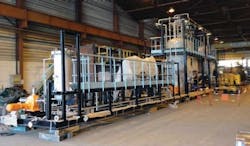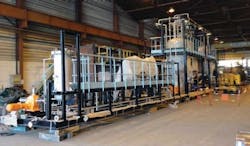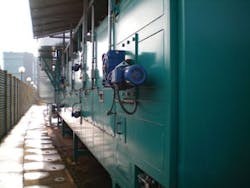County Uses Total Life Cycle Cost to Select Chloramination Analyzers
Dave Marsh
Pasco County Water Utilities in Florida serves its customers with water from 58 permitted wells blended with the water supplied by its large regional supplier, Tampa Bay Water. In 2002 Tampa Bay Water converted to monochloramine disinfection because of its advantages over free residual chlorine. Monochloramine is more stable and better extends the disinfectant residual throughout the distribution system. It also has been shown to reduce the formation of trihalomethanes and halogenic acetic acids while reducing taste and odor problems associated with chlorine. It is also relatively inexpensive to produce.
When Tampa Bay Water adopted monochloramine, Pasco County also converted its entire system to monochloramine so the water from all of its sources would be compatible. In addition to its many pumping stations Pasco has two re-pump stations. Water purchased from Tampa Bay Water is stored until high demand hours and then pumped to the distribution system. It's possible for the water to sit in storage for up to two days and operators must accurately determine the levels of monochloramine, ammonia and chlorine before water is pumped to their customers. Sometimes they have to adjust their chemicals, usually by adding sodium hypochlorite.
Producing monochloramine requires precise control of the process, which necessitated Pasco to upgrade its monitoring and control system with what it thought at the time was the only proven ammonia and monochloramine online analyzer available. The newly installed analyzers used reagents supplied by the manufacturer to measure free ammonia, total ammonia and monochloramine. However, the additional expense of the reagents dramatically increased the county's operating budget.
"There was little we could do to control our increased operating costs," said Jim Kaplan, Water Operations Supervisor. "Because the manufacturer of our analyzers was our only source for the reagents, we could not seek competitive bids. Our costs had increased to over $1200 a month, and we recognized this was not a sustainable solution."
Soon after installing the first analyzer Pasco Water Operations management began investigating other alternatives including the ChemScan UV-2150/S manufactured by ASA Analytics. At the time very few ChemScans were installed in Florida and even fewer municipalities knew much about them.
"Hillsborough County, our neighbor to the south, was using ChemScan. We were able to see their analyzers perform and their operators gave us a very positive reference. Until then, about the only thing we knew about the ChemScans was they were priced $5,000 higher than the analyzers we had already purchased," Kaplan said.
Pasco's Water Operations management saw a couple of significant advantages with the ChemScan that would potentially improve their operating budgets and justify replacing the analyzers they had recently installed. First, the analyzers use reagents that can be produced with common chemicals purchased from any of a number of local distributors. Water Operations management projected the savings would dramatically reduce their monthly chemical expenditures.
Second, the new analyzer also offered more functionality. It could monitor total residual chlorine in addition to the monochloramine, free ammonia, and total ammonia currently measured by the installed analyzers. This would enable operators to maintain tighter control of the intricate chloramination process and save even more money on ammonia and chlorine by applying them more efficiently.
Chloramine is formed by mixing ammonia with free residual chlorine in a complex process depicted by the breakpoint curve that separates the chloramination process into a series of steps. In the early stages of the chloramination process, ammonia added to free residual chlorine produces monochloramine. When the process is optimally controlled, all of the ammonia and available residual chlorine are combined to form monochloramine.
However, inefficient process control will result in an imbalance between the amount of ammonia and the amount of residual chlorine. Excess residual chlorine continues to combine with monochloramine, converting it to dichloramine. The remaining residual chlorine then combines with dichloramine to form trichloramine.
Plant operators without access to real-time, reliable chloramination chemistry data are likely to remain unaware of the problem until they hear from customers complaining about unpleasant tastes and odors from their tap water, which are typically associated with these undesirable chloramine species. While the drinking water is safe for consumption, these characteristics make the water aesthetically unpleasant.
Excess free ammonia is the other type of chemistry imbalance. When allowed to enter the distribution system it will eventually cause problems such as nitrification, algae growth, dissolved oxygen deficiency and corrosion, which are serious and difficult to detect.
Production of a given concentration of monochloramine while avoiding the formation of dichloramine and trichloramine on the one hand or the accumulation of excess ammonia on the other requires adding precise amounts of ammonia and chlorine. Because the ChemScan analyzers monitor all four chloramination process parameters, Pasco operators would have more information to adjust the ammonia and residual chlorine ratios before dichloramine forms.
Pasco tested a ChemScan analyzer to determine whether or not the projected savings could justify making a change.
"We tested the ChemScan for six months and we compared the chemical usage with our current analyzers," said Kaplan. "We also checked the accuracy on an hourly basis using handheld testers. Although they both performed well, we felt that the ChemScan was little bit more accurate. However, there was a big difference in operating costs. The cost of operating the ChemScan was much lower because chemicals were no longer a specialty item we had to purchase from the manufacturer. We would be able to purchase them over the counter like our other supplies."
The side-by-side trial did not conclude with an immediate decision to replace the analyzers. Replacing equipment that had been installed so recently was far from a routine decision. Although Water Operations management advocated the change, Purchasing and Accounting staff members would not be convinced until they could do their due diligence by investigating acquisition costs, operating costs, total life cycle costs and the sunk costs of the analyzers the county had so recently purchased.
In the end the Pasco County determined the service life of the ChemScan would be more than five years longer than the installed analyzers, repair frequency would be less, and savings in chemical costs and repair costs over its extended lifespan would represent a substantial return on the county's investment.
"Like everything, cost was the driving factor," said Kaplan. "And savings over the long-term drove our decisions. Our purchasing department promotes standardization throughout the system, so because we've had good luck with the ChemScans, they're what we now spec in all of our new water treatment plants."
About the Author: Dave Marsh is the Center Manager for the Water Equipment & Policy Industry/University Collaborative Research Center in Wisconsin where scientists work on creating the next generation of water industry products and processes. Marsh previously served as Director of Marketing for US Filter and Culligan Corporations. He can be reached at [email protected].
"ASA Analytics® is an exhibitor at the ACE® '12 event and can be found at Booth No. 1427"
More WaterWorld Current Issue Articles
More WaterWorld Archives Issue Articles


